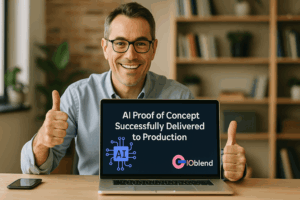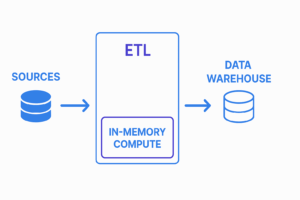Change Data Capture
In the fast-paced world of data management, staying ahead of the curve is not an option, it’s a necessity. Change Data Capture (CDC) is the secret weapon that allows businesses to keep pace with the constant flux of data.
In this blog, we will delve into the world of CDC, explore different approaches to implementing it, provide real-world examples, and understand why CDC is pivotal for modern data management. Furthermore, we will unveil how IOblend automates this crucial process, making it effortless and efficient for organizations.
Understanding Change Data Capture (CDC)
Change Data Capture is the technique of identifying and capturing changes in a database or data source. It allows organizations to track every modification, whether it’s a new record, an update, or a deletion, and transform these changes into a digestible format. CDC ensures that decision-makers have access to the most recent and accurate data, enabling data-driven decisions in real-time.
Various Approaches to Implement CDC
There are several approaches to implementing CDC, each suited for different use cases and infrastructures:
Trigger-Based CDC: This method uses database triggers to capture changes as they occur. When an event (insert, update, delete) happens, the trigger captures and logs the change.
Log-Based CDC: In this approach, CDC relies on the transaction logs of the source database. It reads the log files and identifies changes, making it highly efficient and minimally intrusive.
Query-Based CDC: Query-based CDC periodically scans the source database to identify changes. It’s a flexible approach but can be resource intensive if not optimised for performance.
Hybrid CDC: Combining elements of the above approaches, hybrid CDC offers a balanced solution tailored to specific use cases.
Examples of CDC in Action
E-commerce Inventory Management: Imagine an e-commerce platform that needs to keep track of product availability. With CDC, any change in inventory, such as a new product being added or an existing one going out of stock, is instantly captured. This ensures that customers see up-to-the-minute product availability.
Financial Services: In the finance sector, stock market data changes in real-time. CDC helps financial institutions capture and analyse these changes instantly, allowing traders to make informed decisions on the spot.
Healthcare: CDC plays a crucial role in healthcare, where patient records are continuously updated. Medical professionals can promptly access the latest patient data, such as test results and treatment history.
Why CDC is Essential for Data Management
Change Data Capture is a crucial component of modern architectures and offers several key advantages for data management:
Real-time Decision-Making: CDC provides access to the most current data, enabling organizations to make real-time decisions, which is critical in fast-moving industries.
Data Accuracy: By capturing changes as they occur, CDC reduces the risk of data inconsistencies and inaccuracies.
Efficiency: CDC minimizes the need for resource-intensive batch processing, significantly reducing processing times.
Compliance: In regulated industries like finance and healthcare, CDC ensures data compliance by capturing every change made to sensitive information.
CDC allows transactional data to be available in real-time, without putting stress on the source systems. CDC does not require changes in the source application and reduces the transferred amount of data to a minimum, enhancing data management efficiency.
Change data capture makes it possible to replicate data from source applications to any destination without the burden of extracting or replicating entire datasets.
IOblend: Automating Change Data Capture
IOblend is an end-to-end enterprise data integration solution that incorporates all core DataOps capabilities. Here’s how IOblend streamlines CDC:
Automated Hybrid CDC: IOblend automatically captures changes in your data sources, eliminating the need for manual monitoring. If your system supports log-based CDC, IOblend will track all changes (inserts, updates and deletes) and materialise the full history and/or the latest updates as required. If you are using trigger-based CDC, we will query against the triggers. Finally, we use a highly optimised query-based CDC, a proprietary algorithm to scan for changes between “created” and “modified” dates for each record on reads, placing only minimal stress on the source systems/databases. All three methods require no coding. We give you the full flexibility to deploy any type of CDC that suits your architecture.
Seamless Integration: Perform CDC on any source, perform in-memory transformations, and sink the results to any destination with minimal effort. We combine CDC with advanced ETL capabilities to greatly enrich your data management capabilities without the requirement to code.
No Need for Staging: IOblend’s in-flight ETL capability reduces processing times by performing transformations on the new and updated data without the need for staging. Your data never leaves your security umbrella unlike with most SAAS solutions.
Full DataOps: IOblend covers the entire data journey, from record-level lineage tracking to metadata management, schema evolution, event handling, and much more.
Change Data Capture is a game-changer in the world of data management, and IOblend takes it to the next level with its automation capabilities. With IOblend, you can effortlessly capture changes in your data, reduce processing times, ensure data accuracy, and empower your organization with real-time insights. There is no need to use any additional tools or third-party modules with IOblend – we provide the full “end-to-end” data integration capability out of the box. Embrace the power of CDC with IOblend and stay ahead in the data-driven race.
Download your FREE Developer Edition now and experience the future of data management.
Managing Change Data Capture (CDC) effectively, a crucial component in modern data management, is simplified by IOblend’s automated approach. CDC, the process of identifying and capturing changes in databases or data sources, is pivotal for enabling real-time, data-driven decision-making. IOblend streamlines this with various CDC methods such as trigger-based, log-based, and query-based, suited for different use cases. This automated hybrid CDC ensures real-time data availability, accuracy, and minimizes the need for resource-intensive batch processing. IOblend’s capabilities also extend to seamless integration, in-flight ETL without staging, and full DataOps coverage, including record-level lineage tracking and metadata management. This comprehensive approach makes CDC an efficient and effortless process, allowing businesses to stay agile and informed with up-to-date data insights.

PoC to Production: Accelerating AI Deployment with IOblend
PoC to Production: Accelerating AI Deployment with IOblend 💭 Did You Know? While a staggering 92% of companies are actively experimenting with Artificial Intelligence, a mere 1% ever achieve full maturity in deploying AI solutions at scale. The AI Production Journey A Proof of Concept (PoC) in AI serves as a small-scale, experimental project designed

AI in Healthcare with Smart Data Pipelines
AI in Healthcare: Powering Progress with Smart Data Pipelines 💉 Did you know? Hospitals in the UK alone produce an astonishing 50 petabytes of data per year, more than double the data managed by the US Library of Congress in 2022! What are Data Pipelines for AI Model Training? In the context of healthcare, this means

The Urgency of Now: Real-Time Data in Analytics
The Urgency of Now: Real-Time Data in Analytics ✈️ Did you know? Every minute of delay in airline operations can cost as much as £100 per minute for a single aircraft. With thousands of flights daily, those minutes add up fast. Just like in aviation, in data analytics, even small delays can lead to big

Still Confused in 2025? AI, ML & Data Science Explained
Still Confused in 2025? AI, ML & Data Science Explained…finally It seems everyone in business circles talks about these days. AI will solve all our business challenges and make/save us a ton of money. AI will replace manual labour with clever agents. It will change the world and our business will be at the forefront

Beyond Spreadsheets: The CFO’s Path to Data-Driven Decisions
Beyond Spreadsheets: The CFO’s Path to Data-Driven Decisions 📊 Did you know? Companies leveraging data-driven insights consistently report a significant uplift in profitability – often exceeding 20%. That’s not just a marginal gain; it’s a game-changer. The Data-Driven CFO The modern Chief Financial Officer operates in a world awash with data. No longer solely focused

Shift Left: Unleashing Data Power with In-Memory Processing
Mind the Gap: Bridging Data Shift Left: Unleashing Data Power with In-Memory Processing 💻 Did you know? Organisations that implement shift-left strategies can experience up to a 30% reduction in compute costs by cleaning data at the source. The Essence of Shifting Left Shifting data compute and governance “left” essentially means moving these processes closer

